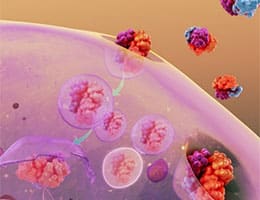 The concept of pinocytosis comes from the English word pinocytosis , in turn derived from the French pinocytose (whose etymological roots are found in Greek). This is the name given to the process that allows a cell to incorporate liquids through the development of vesicles in its plasma membrane .
The concept of pinocytosis comes from the English word pinocytosis , in turn derived from the French pinocytose (whose etymological roots are found in Greek). This is the name given to the process that allows a cell to incorporate liquids through the development of vesicles in its plasma membrane .
Pinocytosis is a type of endocytosis : this is the name given to the mechanism by which a cell introduces particles into its interior through its membrane. Pinocytosis is also often mentioned as the phagocytosis of soluble molecules, phagocytosis being the capture of particles thanks to pseudopodia (extensions of the cytoplasm).
In the specific case of pinocytosis, vesicles develop on the cell surface that is covered by a protein called clathrin . These pinocytic vesicles or pinosomes , through an invagination procedure, reach the cytoplasm. At this point the clathrin coating fades and the vesicles end up fusing with the endosomes and finally arriving at the lysosomes.
It can be said, in short, that pinocytosis begins with the development of a hole in the cell membrane . This gap then invaginates to form the vesicle, closing around the soluble particle until the vesicle detaches from the membrane and is incorporated into the cytoplasm. In colloquial language, without any scientific rigor or precision, it could be stated that this is how the cell manages to “drink” .
It is important to mention that pinocytosis is common in eukaryotic cells . It is estimated that clathrin-coated gaps can occupy about 2% of the cell membrane surface. It is worth mentioning that its life is really short from our point of view, since it usually lasts an average of two minutes.
Pinocytosis can be carried out in two well-defined ways, which we can understand as two types of this same process: fluid and adsorptive pinocytosis. The main difference between the two is the way in which the substances or particles that are suspended are incorporated into the cytoplasm .
 In the case of fluid pinocytosis, the absorption of substances takes place in the form of soluble substances in the fluid itself. The speed at which these enter the cell is directly proportional to the concentration they have in the external environment, but it is also linked to the cell's ability to generate pinocytic vesicles.
In the case of fluid pinocytosis, the absorption of substances takes place in the form of soluble substances in the fluid itself. The speed at which these enter the cell is directly proportional to the concentration they have in the external environment, but it is also linked to the cell's ability to generate pinocytic vesicles.
On the other hand, in adsorptive pinocytosis, the entry rate of the molecule is calculated taking into account its concentration in the extracellular medium and the quantity, function and affinity of the receptors found on the surface of the cell membrane. cell.
To understand this difference we can resort to a general comparison, taking as reference a process of each type of pinocytosis that are under the same conditions, that is, they have the same concentration of molecules to be absorbed: in a case like this, the speed of the adsorptive would exceed that of the fluid in a range that goes from one hundred to one thousand times; In addition, it would have greater efficiency in the absorption of liquids, that is, it would absorb less.
The number of receptors that we find in the cell membrane to selectively introduce macromolecules into its interior exceeds twenty. Throughout pinocytosis, a fluid different from that found in the cytoplasm also enters, but this is not done selectively; this is known as fluid phase endocytosis .
It is possible to find more than one type of receptor in each clathrin-coated cavity. All of them are internalized simultaneously through a single vesicle.
